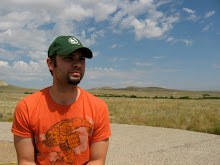
Jeff Smith is pretty great. So far RASL has been energetic and inventive. Shazam and the Monster Society of Evil, though Smith's weakest work, displays a fine balance of restrained ebullience and genuine affection for its characters. But, come on, with Jeff Smith it's all about Bone.
Briefly, though Smith's work deserves much more, Bone is fun to look at through the lens of reading. The relationship between reader and text is one of the big themes of the entire series. The three titular Bones - Fone Bone, Smiley Bone, and Phoney Bone - resemble the hobbits of Tolkien's Lord of the Rings (Smith himself has described Bone as "Bugs Bunny meets Lord of the Rings"). They are the human avatars, the characters allowing a point of entry into a medieval world. The Bones' world, encapsulated in their hometown of Boneville which is never so much as glimpsed, is described as our world would be. It seems to be an industrialized, modern society - a great contrast to the feudal, primarily agrarian world they encounter. The Bones are put in the position of readers right away: they enter the world through reading a map (a map drawn by Thorn, as it turns out, when she was a child ... the story calls out to the reader).

By reading the map, the Bones are led into an adventure. There is a sense that Smith's world is like that of Baum's Oz books: though the adventure is real, it takes place on an imaginary plane, adjacent to the more mundane "reality." Fone Bone loses his companions in a plague of locusts, survives a long fall into a ravine, and emerges in a world that is not at all like the one he knows. Tracing Fone Bone's adventures is a copy of his favourite book, Moby Dick. Fone Bone is a reader, and is willing to launch into an impromptu lecture on Melville's novel if given even the slightest chance. Scenes from Moby Dick barge into Fone Bone's dreaming life and begin to take on a prophetic quality. The book begins to become shape the reality of the reader.
As exemplified by Fone Bone's involvement with Moby Dick, reading becomes more than a passive act. The Bones are important in the narrative, and its actions could not take place without them but they enter a world that precedes them and will continue after they are gone. They must learn the pre-existing relationships and rich back-stories. They are often swept along by events and characters over whom they have no control. In this way, they are like readers of Smith's series, who become involved in the action and are engaged in its production (and what's a comic without a reader?).

The last scene of Bone left me quite dissatisfied the first time I read the series. There seems to be no story logic for why the Bones leave. Why would they want to go back to Boneville? We hear almost nothing about families or close acquaintances back home and they don't seem to miss much about it. As with the Narnia or Oz books, I wondered why the characters would want to leave their friends and adventures behind for the mundane life they had before their life-changing adventures. But that's how reading works. You can tumble into the world for a while, but you always have to leave. When the Bones leave Thorn and Granma Ben behind, it's a sad parting because, like the Bones, you have developed affection for these characters through reading. Like the Bones, you leave them because, eventually, you have to put the book down.


No comments:
Post a Comment